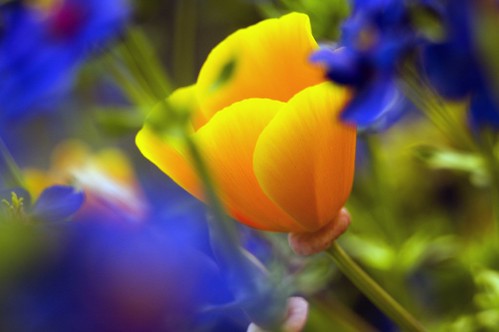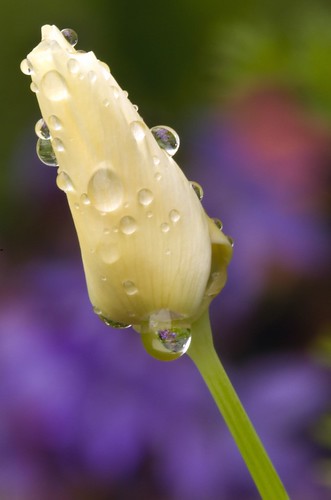The term bokeh is used to refer to blurring in a photograph. Good bokeh is smooth and pleasing, whereas bad bokeh produces a jagged and discordant effect. This may sound subjective, but pretty quickly you can get to recognize excellent bokeh when you see it in a photo. And the effort of doing so will help you improve your photography.
Bokeh generally refers to background blur rather than foreground blur, because background blur tends to be far more important than foreground blur in most compositions. The photo of the California poppy in the wind (below) is an exception to this rule.
Almost everyone can recognize sharpness of an entire composition as effective. Realistically, this can only happen in limited situations. For example, all elements of a photograph must be in focus (this happens in landscape photos at infinity) and everything must be still enough so there is no motion blur.
The way of bokeh is to recognize that almost all photographs have some blurring and out-of-focus elements. Rather than deprecating, the zen of blur is to embrace. If you must have blur, why not make your bokeh the best it can be?
Taking the zen of bokeh one step further, can you conceive of photos that are about blurring rather than sharpness?
View this photograph larger. Read the back story featuring this image.
Bokeh comes from the Japanese word boke (ぼけ), meaning blur. The terminology may also be derived in part from bokashi, a blurring ink wash technique used by great Japanese artists like Hokusai. (Bokashi also seems to be a Japanese composting method.)
In photograph terms, bokeh is caused by a great number of factors, including:
- the lens and its optical design
- the way a scene is lit
- the motion inherent to a subject
- the aperture (f-stop) used
- the quantity of out-of-focus elements in a scene
- the way a scene is lit
Lens designers know that depth-of-field gets shallower for close-up subjects. The converse is also true: Going outwards from infinity there is infinite depth-of-field.
Since macro photography therefore implies shallow depth-of-field, there will be focus blurring even at f/64. Taking this in mind, some speciality macro lenses are made so that they tend to produce good bokeh. As the manual for my Nikon PC Micro-Nikkor 85mm f/2.8D puts this, “Rounded diaphragm opening makes out-of-focus elements appear more natural.” [sic]
View this photograph larger. Read the back story featuring this image.
More important than the technical considerations of what creates good bokeh is the ability of a photographer to recognize pleasing bokeh and to work to enhance it.
You should look closely at the bokeh characteristics of your photos, particularly close-ups and portraits. Experiment. Try to understand what happens to your bokeh when you change your f/stop (use the depth-of-field preview to get a sense of this while taking the photo). Work with your photographic compositions to see if you can enhance the bokeh by slightly changing your position, the lighting, or your precise point of focus.
Realize that the bokeh in a photo is as important, or even more important, than any other element. For example, in the photo I took of a white California poppy below, the flower bud and waterdrops are nice, but the purple bokeh is what makes the photo.
View this image larger. Read the back story featuring this image.



Pingback: Within the Web
Pingback: Creative Effects in the Camera
Pingback: May the best flower photo win
Pingback: Trio of Tulips at Giverny
Pingback: Spider Web Bokeh